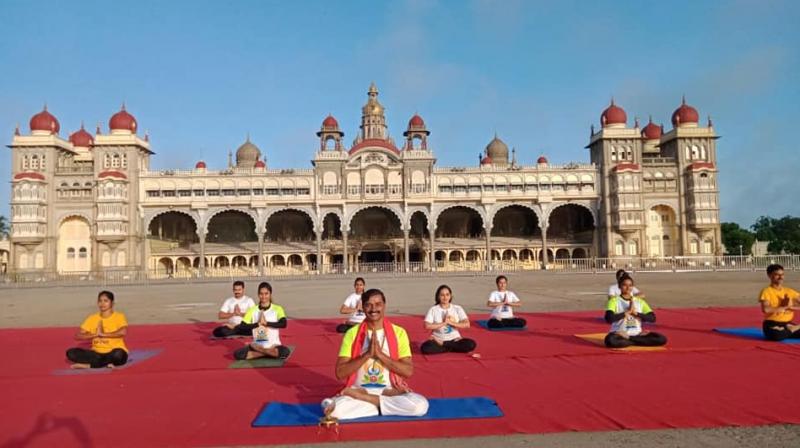India's culture & how it evolved Yoga is exercise, it's not Hinduism
If yoga is Hindu, then karate is Buddhist, kung fu is Confucian and taekwondo also Buddhist

Most of India’s culture has been much influenced and shaped by the successive waves of invasions from the northwest. How we look at it depends on how far back we want to go. The northwestern waves were a continuous process till continental Indian power was consolidated by the rise of the British in the eighteenth and nineteenth centuries.
These hordes were mostly not encumbered by religious ideology or cultural baggage and the Brahmanical elite quite willingly assimilated them into the Hindu fabric and gave them a place in the Hindu social hierarchy. Possibly the last of these hordes were the Buddhist Kushans led by Kanishka who established their dominance over the Aryavarta region, stretching from the Indus to Pataliputra. Kanishka was a descendant of Kujula Kadphishes, founder of the Kushan dynasty that ruled much of Central Asia, including Afghanistan. Buddhism and Brahminical Hinduism had a long history of theological intermingling and cultural exchange.
The waves after this came armed with Islam and the process of complete assimilation ceased. The Afghan and Mughal kings of Delhi too shared pretty much the same geographical origins as Kanishka and those before him. But Islam made them different. This difference gave rise to a new era of, for lack of a better description, separate development, which was what apartheid was also meant to be. That separateness can be seen even today. But it wasn’t as if racial and cultural intermingling ceased. While it was common, it was no longer the norm. Yet the pre-British story of India was how these two great theologies and cultures fused to give the region new languages, art forms, literature, music and architecture. Among the greatest exponents of our ragas and sangeet were Muslims, just as Hindus like Firaq Gorakhpuri (Raghupati Sahay) and Ram Prasad Bismil became great writers in Urdu. Only our theologies became impervious and separate dogmas. Bade Ghulam Ali Khan and Bismillah Khan were not singing Hindu songs and playing Hindu ragas, just as Wadali Brothers, Puranchand and Pyarelal, were not singing Muslim songs. Unfortunately, of late we have seen an acceleration towards separation when with time we should be seeing more creative fusion.
The All-India Muslim Personal Law Board, the VHP’s Muslim version, opposes the celebration of International Yoga Day on June 21. This is utterly misguided, unfortunate and silly. It calls yoga a religious symbol. It is not. Today it’s just a school of balance-focused exercises, pure and simple. Like Tai Chi. I wonder what they would say about Hyderabad’s Nawab Sadiq Jung Bahadur “Hilm”, who wrote: “Kanhaiya yaad hai kuch bhi hamaari”; or Mah Laqa Bai or Chanda Bibi, who had a diwan or collection of poems in Dakhni called “Gulzar-e-Mahlaqa”?
Yoga, like jihad, takes different meanings by what is prefixed or suffixed to it. Jihad is an Arabic word that just means “striving” or “struggling”, especially with a praiseworthy aim. It was meant as self-betterment, but in the Islamic context it has acquired very different meanings. Yoga as exercise is a physical activity -- mainly of postures in sequences that are sometimes accompanied by breathing exercises. It’s this yoga that has become familiar worldwide, especially in Europe and the United States. It is derived from the postures used in the medieval spiritual discipline of Hatha Yoga.
The AIMPLB specifically cites Surya Namaskar as offensive, but it’s just a common sequence of asanas. Most Hindus revere the Sun as it is the giver of life and sustenance. Due to this, some Hindus set aside a part of their daily worship for salutations to the Sun by prostrations. This method of adoration affords them so much muscular activity that it takes to some extent the place of physical exercise. Muslims can practise these same asanas without worshipping the Sun. But before they reject the Sun salutation, they’ll do well to recall Allama Iqbal, who wrote: “Ai aaftaab! Hum ko zia-e-shaoor de/ Chasm-e-khird ko apni tajjali se noor de.” (O radiant one! Grant us the grace of wisdom/Let our eyes see reason in your resplendent glow.)
I only hope some of the “grace of wisdom” will penetrate the dark recesses of minds in the AIMPLB. Muslims as whole will do well to listen to saner voices in the community like Prof. Mohammed Abbas Niazi of AMU, who said: “Yoga is an exercise, and no religion is against a healthy lifestyle.” Or quietly just don’t do yoga, without making a hullabaloo over it. But don’t dismiss it as unsecular. Yoga is no extension of Hinduism, just as a raga isn’t. The Brihaddeshi describes raga as “a combination of tones which, with beautiful illuminating graces, pleases people”.
Modern yoga practices’ only link with Hinduism is that it evolved in India. By this standard, they must oppose many mathematical principles that evolved in ancient India and think of algebra as an exclusive Islamic discipline. Yoga is a non-sectarian physical and mental health-oriented set of exercises. If yoga is Hindu, then karate is Buddhist, kung fu is Confucian and taekwondo also Buddhist. Will the AIMPLB seek a ban on them too?
The RSS and BJP governments all over India are trying to impose yoga as an exercise in schools. Like any exercise, this too should be optional. Those who want to skip yoga can use it for some other form of exercise. But exercise is a must. When I was in school, we used to have an exercise period every day. Some played soccer, others played kabaddi, some just marched about, drilled by the NCC instructor. We didn’t have yoga then. It was still a Western fad.
Monday, June 21, is International Yoga Day

